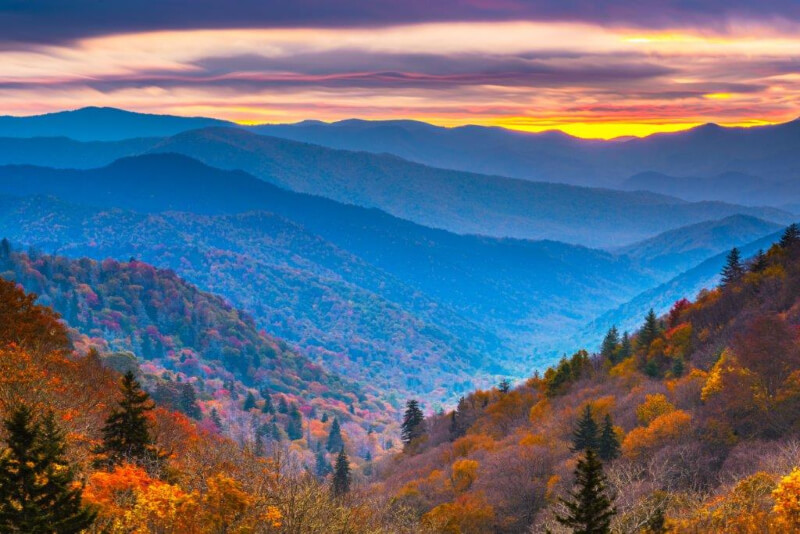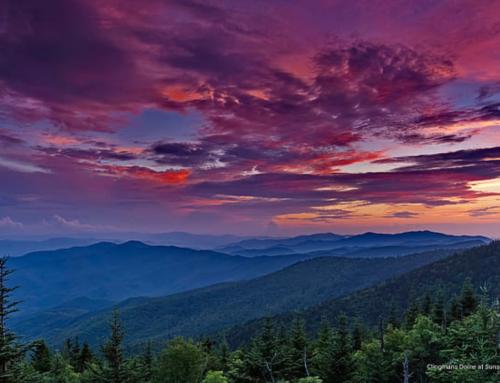The Western North Carolina Great Smoky Mountains are filled with Appalachian culture, fascinating history, and breathtaking natural beauty. Home to a wide variety of plants and animals, with hiking trails, waterfalls, and plenty of places to explore, this entire region is an amazing escape into the fresh air and unforgettable memories. It’s no wonder that millions of people visit every year. But before you plan your next trip to the Smokies, read up on these fun facts that just might surprise you.
-
The Smokies are Some of the Oldest Mountains in the Entire World
The Great Smoky Mountains are estimated to be between 200 and 300 million years old! By examining the amount of weathering that the area’s rocks have experienced as well as using the age of the particles found in local soil and trees, scientists have been able to determine just how ancient these incredible mountains are. And considering that the Great Smoky Mountains National Park is barely 100 years old itself, there is still so much more history to learn.
-
The “Smoke” is Created by Plants
The mesmerizing mist that hovers over the peaks is what gives the Smoky Mountains its iconic name. The Cherokee call this ancient range “Shaconage” (Sha-Kon-O-Hey). It means the “Land of Blue Smoke. But it’s not actually smoke. The blue-hued fog is created by native plants that give off something called a volatile organic compound, or VOC. As the VOCs increase, they come together to form a vapor, which when released, scatters blue light from the sky. And that’s when you get the distinctive and unforgettable sight that so many people travel to the Smokies to see.
-
There is No Entrance Fee to Visit the Park
The Great Smoky Mountains National Park is completely free for anyone who wants to visit. It all goes back to the fact that this was the first national park to be partially funded by the federal government. When construction of Newfound Gap Road began, the state of Tennessee transferred ownership to the government on the condition that there would never be a toll or license fee charged for its use. At the time, Newfound Gap Road was the only way to travel between local communities, and leaders wanted the road to be free and convenient. The rest of the funds for the park – a whopping $5 million – were donated by John D. Rockefeller, Jr. and local citizens.
-
The Western North Carolina Side of the Great Smoky Mountains is Home To One Of the Only Elk Herds In The Eastern US
Centuries ago, vast numbers of elk in North Carolina called the state’s woodlands and forests home. They were one of the most popular game animals, but overhunting – as well as loss of habitat from settlers moving in – quickly led to a decline in the elk population. The last of the eastern elk in North Carolina was killed in the 1790s, and the species disappeared from the landscape.
Thankfully, the elk have been reintroduced to the region, and the herd has grown to nearly 200. Today, you can see them roaming and grazing in North Carolina’s Cataloochee Valley and in the fields that surround the Oconaluftee Visitors Center in Cherokee. As you’re viewing the elk, though, remember that these wild creatures weigh around 700 pounds and are the largest animal in the Great Smoky Mountains National Park. So, exercise extreme caution and keep a safe distance when admiring these impressive animals.
-
The Smokies are the Salamander Capital of the World
The Great Smoky Mountains are the unofficial Salamander Capital of the World. There are over 30 different species of salamanders living in the park, and 24 of them are unique lungless salamanders. Instead of lungs, they “breathe” through tiny blood vessels in their skin and the linings of their throats and mouths. Keep an eye out for them around creeks and under rocks.
-
GSMNP is Home to Synchronous Fireflies
Every summer – for a couple of extraordinary weeks – the secret world of fireflies opens up under the cover of darkness, and we mere humans have a rare opportunity to observe one of nature’s wildest nighttime displays. The synchronous fireflies that live in the Elkmont region of the Great Smoky Mountains National Park (one of at least 19 different species) begin to flash in unison as part of an awe-inspiring mating ritual. The peak mating season usually lasts around two weeks each year, ranging from the end of May to the beginning of June.
-
The Park’s Most Famous Resident is a Symbol of the Smokies
The Great Smoky Mountains National Park is home to approximately 1,600 black bears, and they live at all elevations throughout the park. This high density of bears makes the Great Smoky Mountains National Park a prime spot for viewing them in their natural habitat. In fact, sometimes you may encounter “bear jam,” where the road gets backed up with a long line of vehicles as visitors pause to take photos of a black bear strolling near the roadside. Just remember – these are wild animals, and you’re in their home. So, be sure to keep a safe and respectful distance while marveling at their beauty.
-
Enjoy the 2,900 Miles of Streams
The Smokies are home to approximately 2,900 miles of refreshing streams…and you can fish in all of them! A lot of the streams also result in some pretty spectacular waterfalls like Soco Falls, Looking Glass Falls, and Sliding Rock – a natural waterslide that’s better than any theme park. Every year more than 20,000 people hike to see these cascading beauties.
-
Discover More than 800 Miles of Hiking Trails
Speaking of hiking, there are more than 800 miles of hiking trails in the park. Hiking is the best way to get up close and personal with the beauty of nature. In the winter, you can explore enchanting frozen waterfalls, and spring hikes boast breathtaking fields of wildflowers. Lace up those boots and get ready to hit the trails!
-
The GSMNP is Only a Day’s Drive from Two-Thirds of the Country
One of the main reasons the Great Smoky Mountains National Park is the most visited park in the entire US is its convenient location. It straddles the border of East Tennessee and Western North Carolina and is easily accessed from Interstate Highway 40. A few of the major metro areas that are nearby are:
Asheville, NC – 2 hours
Charlotte, NC – 4 hours
Nashville,TN – 3 hours, 40 minutes
Lexington, KY – 3 hours, 40 minutes
Atlanta, GA – 4 hours
-
Bonus Fact: Three Entrances to the Park are Within 20 Miles of the Meadowlark Motel
You can easily access the park from Meadowlark Motel. Cataloochee Valley, Oconaluftee, and Balsam Mountain entrances are all less than 20 miles away from our front door. After exploring the park, get a great night’s rest in our rooms and cabins decorated with a relaxing Appalachian chic style. We’ve also got amenities like fun games and live musical performances on our BackPorch Pavilion. Give us a call at 828-926-1717 or visit our website to book your stay. We can’t wait to see you!








